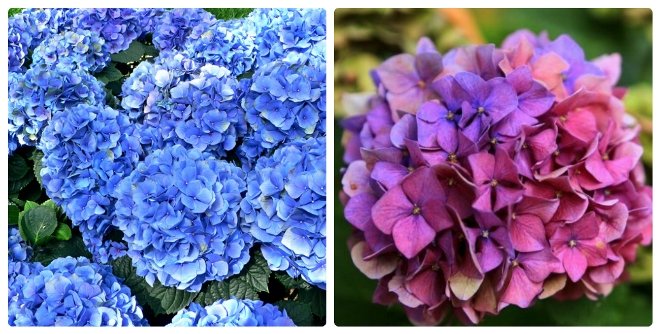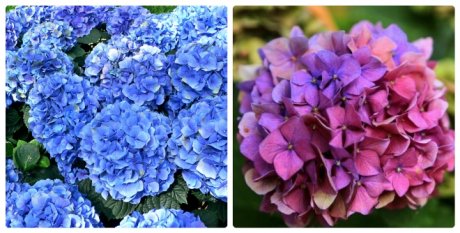Hydrangea to be pink. Change the color of hydrangea
Hydrangea is considered one of the most beautiful flowering shrubs. Lush spherical inflorescences, behind which you can hardly see the foliage, will decorate even an unkempt garden.
Many people know that the color of hydrangea flowers can be changed. Make blue or blue from pink, and purple from red. However, it should be noted that not all varieties lend themselves to staining. For example, it will never be possible to get a blue hydrangea from a white hydrangea. For pink or blue flowers, you need a large-flowered hydrangea, Hydrangea macrophylla.
The color of a hydrangea depends a lot on the soil on which it grows. By the color of the inflorescences, you can determine the acid-base reaction of the soil. On soils with a slightly alkaline reaction, plants will bloom with pink flowers, on acidic soils - blue and even blue. Therefore, if you prepare the substrate in advance and choose the right place for planting the shrub, you can get the desired color of flowers without the use of special preparations.
Blue hydrangea
To obtain a blue color, a slightly acidic soil and a high content of metal salts are needed, which in a neutral or alkaline medium turn into insoluble forms and cannot be fully absorbed by the plant. To get a rich blue hue, you need to do the following:
Measure the pH of the soil, it should be in the range of 5.3 - 5.5. Only at such rates will metal salts become available to hydrangeas. Higher pH values \u200b\u200bwill result in magenta-tinged transition colors.
Buy aluminum sulfate or potassium alum to lower the pH if needed. You can also use iron alum and even iron filings or rusty nails that are dug into the ground around the bush.
It is recommended to add dry aluminum sulfate in the following proportions: per 1 m² to 0.5 kg of dry aluminum sulfate. You can dissolve alum or aluminum sulfate in water and water the bushes every one to two weeks, but not less often. At the same time, observe the proportions: 30 - 40 g of sulfate or alum should be taken in a bucket of water. The norm for one adult bush is two or three buckets. Otherwise, the color will change partially.
To increase the acidity, you can add dissolved peat, apple cider infusion, sawdust, chopped grass under the bush.
Fertilization also affects discoloration. Fertilizing with physiologically acidic compound fertilizers with low phosphorus, high potassium and medium nitrogen levels will help produce a good blue color. The optimal ratio is N: P: K close to 10: 5: 20. Do not use superphosphate and bone meal, which are sometimes used for fuller flowering.
It is important to know that too a large number of the added alum can cause death of the roots, so do not strive for a quick effect and observe the norms when diluting the solution.
Pink hydrangea
The pink color of hydrangea appears with a decrease in soil acidity.
The acidity should be in the range of 6.0 to 6.5 units. With such acidity, hydrangea is not able to assimilate metal salts from the soil, and, therefore, will not "turn blue." If the figure is higher, the plant may suffer from lack of nutrients. You do not need to strive for the soil to be truly alkaline, because the plant will develop chlorosis.
Add dolomite flour, lime, or ground limestone to raise the soil pH to 6.0 - 6.5. If the acidity is too high, they need to be applied several times a year.
To maintain an intense pink color, feed the bushes with fertilizers that are sufficiently high in nitrogen and phosphorus, but low level potassium. Phosphorus forms insoluble materials with aluminum chemical compounds, and the metal is not assimilated by the plant. Select a fertilizer type with an N: P: K ratio close to 25:10:10. Ammonium monophosphate can be used (11:53:00).
If the soil in the entire area is very acidic, then it is more convenient to grow pink hydrangea in separate containers, pouring landless substrates into them, for example, peat. There are practically no aluminum compounds in peat. In such containers, it is much easier to maintain the regime necessary for the plant.
Plants that require acidic soil (rhododendrons, azaleas) should not be grown next to pink hydrangea.
When your hydrangeas turn blue or pink, adding additional soil additives will not help enhance the color depth. Color may vary from season to season due to weather conditions, stresses experienced by plants, and environment... For example, plants planted near a concrete foundation or concrete walkway may never turn blue due to the lime leaching from the concrete.
It should be borne in mind that a change in the color of a hydrangea occurs as the plant develops and matures, therefore, by planting, for example, a pink hydrangea in acidic soil, you will be able to see blue inflorescences only after a few years.
If the natural garden soil is acidic enough below 5.5 and contains aluminum, the hydrangea will automatically tend to shades of blue or purple.
If the soil in the garden is neutral or alkaline, it is necessary to artificially acidify it in the root zone to a depth of 20-30 cm or replace the soil in the planting pit with a previously prepared acidic soil. You can acidify non-carbonate soil to pH 5.0-5.5 with high-moor peat or agricultural elemental sulfur before planting hydrangeas. Subsequently, a low pH is maintained by regularly watering the plant with a solution (15 g / l) of aluminum sulfate during the entire growing season. Do not water dry soil, pre-moisten it well with clean water.
Mulch the soil near the hydrangea with acidic materials - high peat, coniferous bark. Do not use marble chips, expanded clay.
It is important that irrigation water does not "contaminate" the soil with calcium. The pH of the water should not be higher than 5.6.
Soil alkalinity can rise significantly due to lime leaching from building materials. Therefore, the concrete foundation or sidewalk next to which the hydrangea is planted can affect the color.
Fertilization also affects discoloration. Fertilizing with physiologically acidic compound fertilizers with low phosphorus, high potassium and medium nitrogen levels will help produce a good blue color. The optimal ratio is N: P: K close to 10: 5: 20. Do not use superphosphate and bone meal.
It is difficult to maintain a low pH value in alkaline carbonate soils for a long time, or soils contaminated with alkaline building materials. In this case, it is better to grow blue hydrangeas in large pots using special acidic peat substrates with aluminum sulfate. 5-10% by volume clay can be added to the substrate for aluminum enrichment. The best choice will be an acidic substrate for conifers and rhododendrons. In a container it will be much easier to maintain conditions favorable for growing blue hydrangeas, and you can also grow varieties that require shelter for the winter.
For a liter of acidic substrate, add 1.5 g / l of powdered aluminum sulfate. Mix well, moisten and stand for several days. Another way - plants in pots should be watered with a solution of aluminum sulfate (concentration 10-15 g / l) at the rate of 100 ml of solution per liter of substrate. Monitor the pH of the substrate. For a peat substrate, the optimal pH value is 4.0-4.5. Repeat the procedure after two weeks if necessary. To avoid chemical burns to the roots, fill only a pre-moistened substrate with aluminum sulfate solution. Keep the leaves away from the solution.
It is often asked whether it is possible to change the white flowers of a tree hydrangea to blue. The answer is unequivocal - only large-leaved hydrangea has the ability to change color. White flowers even have large-leaved hydrangea do not stain at all. By the end of summer, they can acquire only a pink bloom, similar to a blush, and purple spots and dots will appear on the petals. 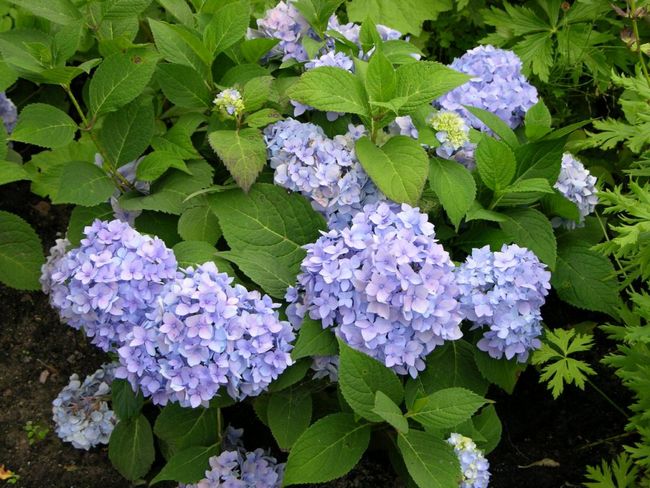 Aluminum salts give a blue color. Changing the color of a hydrangea from pink to blue is easier than changing from blue to pink. Changing from pink to blue involves adding aluminum to the soil, and from blue to pink means removing aluminum from the soil or making it inaccessible to hydrangeas.
Aluminum salts give a blue color. Changing the color of a hydrangea from pink to blue is easier than changing from blue to pink. Changing from pink to blue involves adding aluminum to the soil, and from blue to pink means removing aluminum from the soil or making it inaccessible to hydrangeas. 
"Recolor" in pink
Add dolomite flour several times per season to help reduce acidity. Hydrangea absorbs aluminum better from acidic soils and, therefore, to prevent this, the pH must be brought to 6.0-6.2. At pH values \u200b\u200babove 6.4, hydrangeas can suffer from iron deficiency. Since it absorbs aluminum better at low pH values, raising it will help to contain the bluing effect.
Use fertilizers with a high phosphorus content - it prevents aluminum from entering the plant. Choose fertilizers containing NPK elements ~ 25:10:10.
If you grow mostly blue hydrangeas (soil contains aluminum), grow pink hydrangeas in containers with pink hydrangea growing medium. 
"Recolor" in blue
There should be aluminum in the soil - dig aluminum sulfate around the bush. Recommended for 1 sq. m add 500 g of dry aluminum sulfate. In order for the color of the flowers to be true blue, you will have to apply it several times during the year, especially if the soil has a high pH. There is water-soluble aluminum sulfate, which is added to water during irrigation.
You can prepare a solution (15 g of aluminum sulfate / 4 l of water) and water it with a 2-3 year old bush. Experts recommend watering twice with a solution of potassium alum (30-40 g / 1 bucket of water). For an adult bush with one watering - two or three buckets, otherwise the color change will be partial.
For aluminum to be available to the plant, the soil pH should be no higher than 5.2-5.5. At a pH of 5.5 to 6.0, you will get a transitional color, shades of magenta. Firstly, aluminum sulfate itself increases acidity, and secondly, you can add organic matter, coffee grounds, cut grass, sawdust, shavings, apple infusion.
Choose fertilizers that are low in phosphorus and high in potassium (NPK \u003d 20: 5: 30), this will enhance the blue color. If you want blue flowers, avoid adding superphosphate and bone meal.
Once your hydrangea is bright blue or light blue, patiently create and maintain the conditions required to keep the color. Plants should not be planted in slightly acidic or alkaline soil, even for a short time, water for irrigating hydrangeas should not be alkaline (pH not higher than 5.5).
If the soil in the area is not acidic, you will need to keep the plant in a large container. So it is easier to control the composition of the soil and you can halve the concentration of aluminum sulfate solution during irrigation.
What plays a more significant role in the color - the acidity of the soil or the presence of aluminum in it? Scientists have proven that the presence of aluminum in soil has a blue color greater importancethan hyperacidity. 
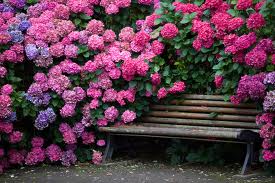
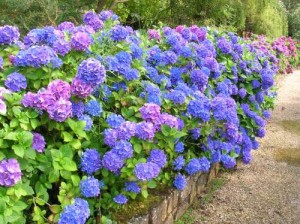
Landing
In our ornamental gardening, several types of this beautiful plant are used: tree hydrangea (Hydrangea arborescens), panicle hydrangea, petiolate hydrangea, Bretschneider hydrangea (H. bretschneideri), as well as large-leaved or garden hydrangea (H. macrophylla). Hydrangeas are planted singly or in groups on the lawn. For anyone garden plot, park and square they will be a real decoration. For them, you should choose well-lit areas with loose, organic-rich, moderately moist soils that have a neutral or slightly acidic reaction. Poor soils can also be suitable for tree hydrangea, although its flowering will be less intense. It is also the most drought-resistant of all species, while panicle hydrangea is more moisture-loving, and for large-leaved hydrangea, drying out is fraught with death.
Care
To improve the aeration of the roots, it is necessary to loosen the soil surface around the bushes several times a year to a depth of 5 cm.Since hydrangea is a very moisture-loving plant, it should be watered every week, the trunks need to be peat or sawdust, the layer of which should be about 6 cm. Very important for hydrangeas correct pruning... It should be done in early spring, before the active growing season begins. Old inflorescences should be removed before the first pair of strong and healthy buds. It is also useful to annually prune several old, weak or too densely spaced branches at the root of mature plants.


In large-leaved hydrangeas, only old, dried inflorescences and poorly overwintered shoots are removed

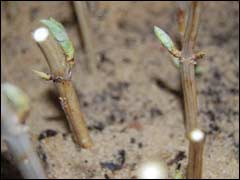
In hydrangea tree-like and hydrangea paniculate in spring or late autumn, all shoots are cut to the width of a palm from the ground
For the lush flowering of hydrangeas, you must regularly fertilize. For feeding adult plants (per 1 sq. M of soil) in the spring, at the beginning of plant growth, add: 20–25 g of urea, 30–40 g of superphosphate, 30–35 g of sulfuric potassium. During the budding period: 60–80 g of superphosphate, 40–45 g of potassium sulfate. At the end of summer, under each shrub: 15–20 kg of rotted manure or compost. To make the shoots more durable, you can water the bushes with a weak solution of potassium permanganate, although the hydrangea is quite resistant to both diseases and pests.
How to grow a colored hydrangea
The color of the hydrangea depends on the variety and variety, soil pH, the presence and availability of aluminum, the type of fertilizer used.
After transplanting, hydrangeas adapt to new conditions and often change color on their own. The next year after planting, you can see several different flowers on the same shrub. Most hydrangea varieties will bloom blue in acidic soils (pH 5.5 and below), while in neutral or alkaline soils (pH 6.5 and above), the flowers will generally be pink. Between pH 5.5 and pH 6.5, the flowers will be purple or a mixture of blue and pink on the same plant.
To control the color of the hydrangeas planted in the garden, it is necessary to regulate the acidity of the soil pH. It is easier to control the color of hydrangeas grown in containers. It is much easier to maintain or change the pH of a substrate in a container than in soil.
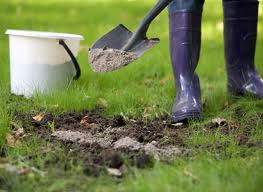
To raise the pH, add lime materials (chalk, dolomite, lime). Sulfur and aluminum sulfate are used to lower the pH. The addition of acidic organic material (peat, sawdust, pine bark) can also help lower soil pH. The exact amount of lime or aluminum sulfate required to achieve the desired color will vary depending on the current soil pH and soil type. For example, to change the pH from 6.0 to 5.0, it is necessary to add 110 g per square meter for loam, 60 g for sand, and 160 g per square meter of elemental sulfur for clay. Effective methods, such as iron chelate treatment or soil acidification with iron sulfate.
Watering
Hydrangea is an exceptionally moisture-loving plant. It should be watered abundantly in the summer (30-50 liters of water for each adult plant) and regularly - twice a week in dry weather and once if it was raining. The number of irrigations can be reduced to one time even if the soil is mulched with peat, which retains moisture for a long time and gradually gives it to plants.
Reproduction and transplantation
Hydrangea is propagated by dividing the bush, layering and cuttings. For cuttings, they take lignified and green cuttings, which can be propagated in winter. To do this, they are cut in the fall and stored in the refrigerator in plastic bags filled with wet sand. In February, they are planted in pots with a soil mixture of sod land, peat and washed river sand. You should also take care of good drainage. Before planting in a pot, the lower part of the cutting should be dipped in 1% heteroauxin powder with talc. After watering, cuttings should be covered plastic wrap and keep in a bright place at a temperature of 20 ° C to 22 ° C. In about a month, green shoots should appear, which should be planted in a greenhouse with shading at the end of April. At the end of summer, when the cuttings are well rooted and can be planted in a permanent place. When transplanting, plants are placed at a distance of 1 to 1.5 m from each other, making holes up to 60 cm deep and adding fertilizers such as organic matter, urea, granular superphosphate, potassium sulfate to them. After such planting, the plant does not need to be fed for 2 years. Then it is necessary to carry out up to several dressings per year: the first falls in the spring (the period of the beginning of growth), the second - during the period of bud appearance, the third and fourth dressings are carried out in the summer.
Diseases and pests
Subject to the conditions of care, hydrangea rarely gets sick, and yet, it is susceptible to some diseases. For example, if yellow mosaic spots or stripes appear on the leaves, it means that the plant has overtaken such a viral disease as mosaic leaf disease. In this case, the affected shoots are cut out and burned, and with a strong spread of the disease, the entire plant is destroyed.
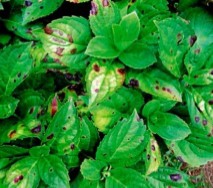
Is it possible to change the color of a hydrangea when it is already in bloom? Yes, and this does not require complex feeding or paint. You just need to slightly change the acidity of the soil and maintain it at the required level.
Love to watch your hydrangea bloom, but no longer like its color? Sometimes this flower arbitrarily changes color after transplanting to a new place and adapting to new soil. But this process can be controlled by changing and calibrating the composition of the soil, creating special conditions and microclimate for the plant. However, you can only "play" with the color of large-leaved hydrangeas (pink and blue) varieties. White hydrangeas cannot change color, the maximum that will happen to them is that by the end of summer they will turn slightly pink, as if they will be covered with bloom.
Testing the soil
Before embarking on experiments on changing the color of hydrangeas, you should find out the level of acidity of the soil. Use litmus paper or a pH meter to measure soil parameters. Acidic soil (below pH 7) will allow blue hydrangea to grow. Alkaline soil (with a pH above 7) will give you pink flowers... Once you have received the measurement results, you can proceed to change the soil composition.
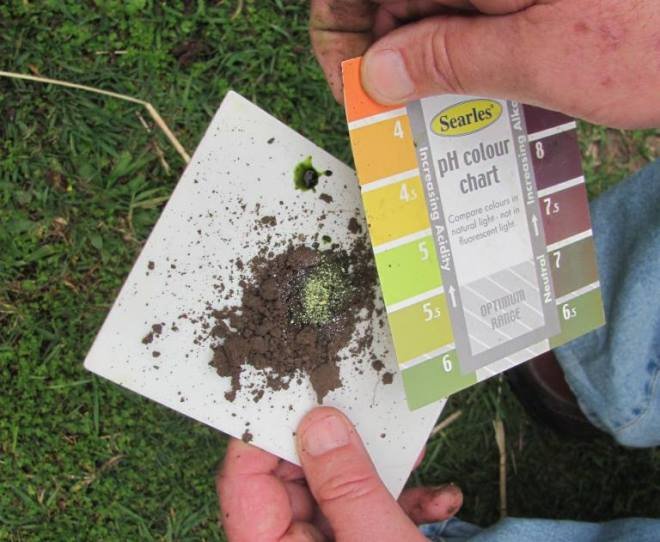

Change the color from pink to blue
So, if you are growing pink hydrangeas (which require alkaline soil) but want to turn them blue, you need to increase the acidity of the soil.
To change the color of hydrangea from pink to blue, you just need to increase the concentration of aluminum in the soil.
It is not necessary to bury anything metallic in the ground for the plant to begin to change color. It is enough to pour pine needles, compost, ground coffee and aluminum sulfate into the pot or tree trunk circle. Keep in mind that changing the pH level is a long process and the pink hydrangea won't turn blue the next day. Be patient - it can take a bush about a year to completely change color.
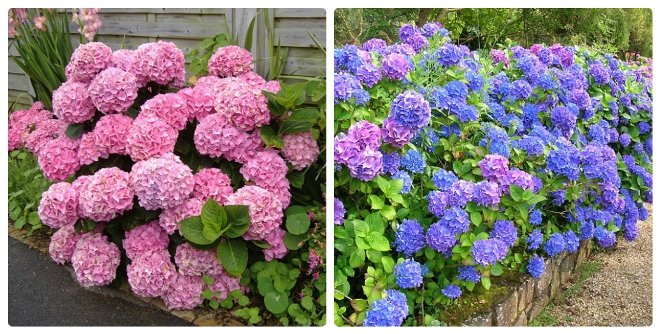
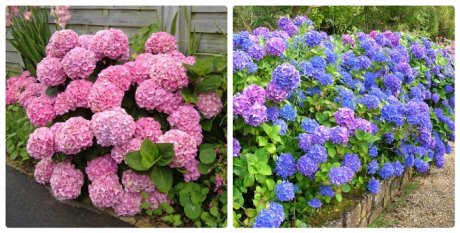
If the soil in your garden is alkaline, sources of aluminum will need to be added from time to time throughout the growing season to “fix” the blue color of the hydrangea. The easiest way is to use aluminum sulfate at the rate of 4 tbsp. 4.5 liters of water (the solution is watered under the root of the bushes every 2-4 weeks).
If you have extensive plantings of hydrangeas on your site, then up to 500 g of dry aluminum sulfate can be applied to 1 square meter of soil. In the future, you can water the bushes with potassium alum twice a year at the rate of 30-40 g / 10 l of water. For one adult bush, spend 2-3 buckets of solution.
Change the color from blue to pink
To start the opposite process, that is, to change the color of the hydrangea from blue to pink, you need, on the contrary, to remove excess aluminum from the soil. The easiest way is to add dolomite flour to raise the pH. Start by scattering 3-4 cups of dolomite flour around the bush. Then apply the same dose every 2-3 weeks throughout the growth period.
